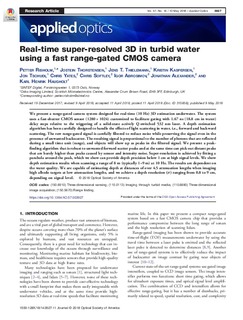Real-time super-resolved 3D in turbid water using a fast range-gated CMOS camera
Risholm, Petter; Thorstensen, Jostein Bruun; Thielemann, Jens T; Kaspersen, Kristin; Tschudi, Jon; Yates, Chris; Softley, Chris; Abrosimov, Igor; Alexander, Jonathan; Haugholt, Karl Henrik
Journal article, Peer reviewed
Published version
Permanent lenke
http://hdl.handle.net/11250/2568745Utgivelsesdato
2018Metadata
Vis full innførselSamlinger
- Publikasjoner fra CRIStin - SINTEF AS [5802]
- SINTEF Digital [2501]
Sammendrag
We present a range-gated camera system designed for real-time (10 Hz) 3D estimation underwater. The system uses a fast-shutter CMOS sensor (1280×1024 1280×1024 ) customized to facilitate gating with 1.67 ns (18.8 cm in water) delay steps relative to the triggering of a solid-state actively Q -switched 532 nm laser. A depth estimation algorithm has been carefully designed to handle the effects of light scattering in water, i.e., forward and backward scattering. The raw range-gated signal is carefully filtered to reduce noise while preserving the signal even in the presence of unwanted backscatter. The resulting signal is proportional to the number of photons that are reflected during a small time unit (range), and objects will show up as peaks in the filtered signal. We present a peak-finding algorithm that is robust to unwanted forward scatter peaks and at the same time can pick out distant peaks that are barely higher than peaks caused by sensor and intensity noise. Super-resolution is achieved by fitting a parabola around the peak, which we show can provide depth precision below 1 cm at high signal levels. We show depth estimation results when scanning a range of 8 m (typically 1–9 m) at 10 Hz. The results are dependent on the water quality. We are capable of estimating depth at distances of over 4.5 attenuation lengths when imaging high albedo targets at low attenuation lengths, and we achieve a depth resolution () (σ)ranging from 0.8 to 9 cm, depending on signal level.
